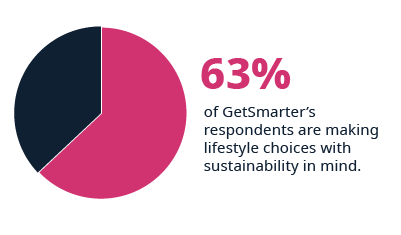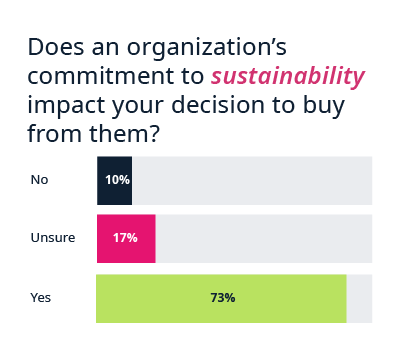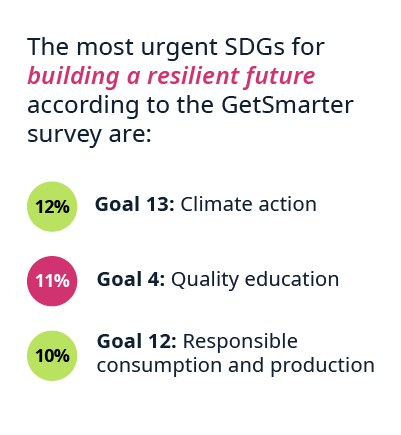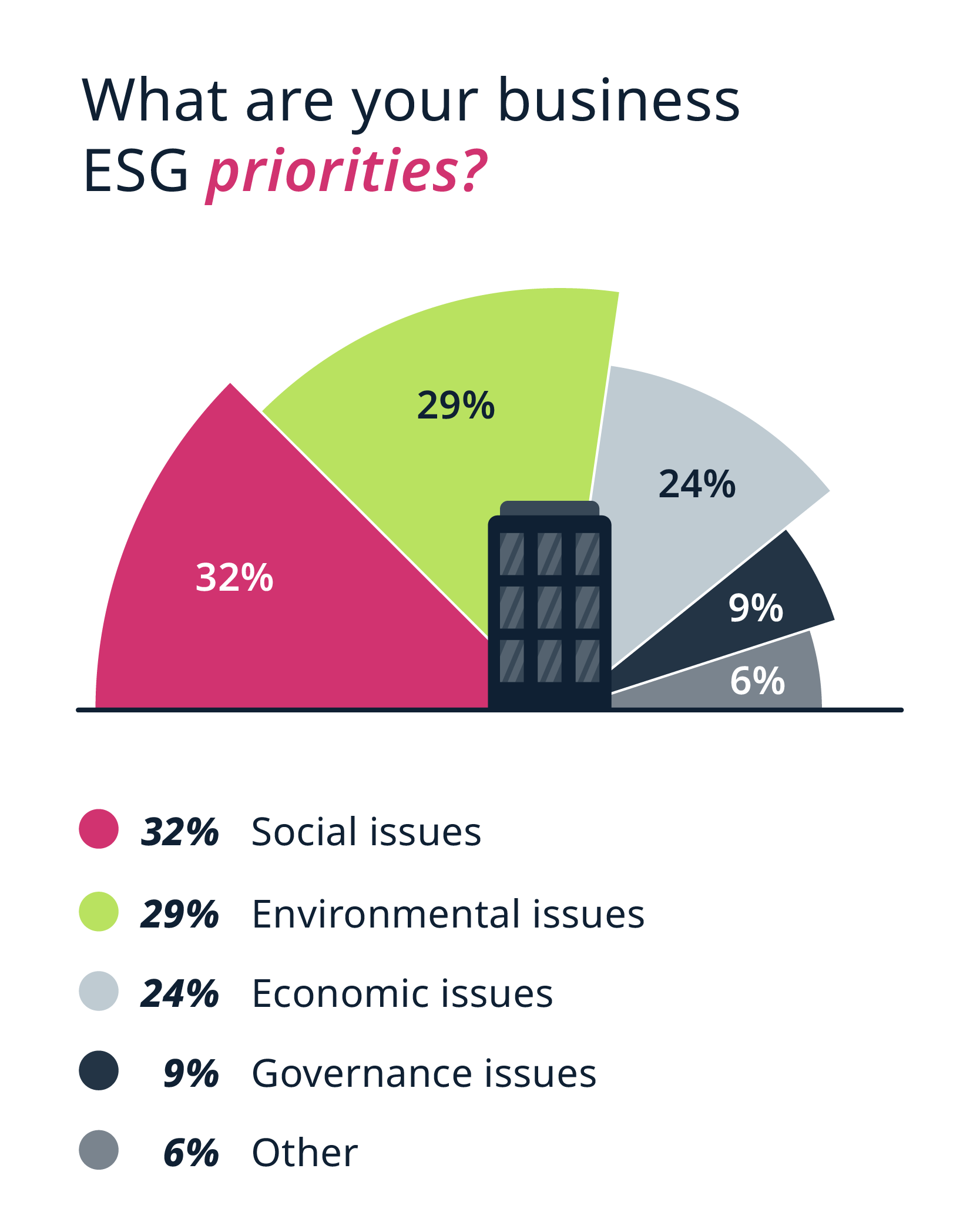How a Sustainability Strategy Can Boost Customer Engagement and Grow Your Business
The pandemic, climate crisis, and growing inequality have all highlighted the urgency for businesses to take a bigger role in building sustainable practices. But the future health of our planet and people isn’t the only motivation for companies to drive change. Research from GetSmarter’s global report, ‘Sustainability: The Meaning, Changing Perceptions, and Expanding Agendas’, shows that 63% of respondents are making lifestyle choices with sustainability in mind, a 10% increase from pre-pandemic levels. As consumers worldwide adapt their spending habits, there are vital economic benefits to creating a sound sustainability strategy for companies of all sizes and across all industries, but especially for entrepreneurs and small- to medium-sized enterprises (SMEs) that lack the resources that larger corporations have.

Sustainability offers business benefits
The pandemic and climate crisis have affected supply chains and operations for companies across the globe, but prioritizing sustainability can help you build financial resilience. Sustainable strategies like circular production can offer greater pricing power, more efficient use of resources, and provide more sources of revenue.
On the people front, sustainable practices also attract and retain talent, improve customer loyalty, and help you enter new markets.1 They can help build inclusive businesses that earn more social support, industry recognition, and community loyalty. Another important opportunity is the reduction of operating costs through solar or eco-conscious systems. Safeguarding your operations now will also help protect you from growing environmental threats to your business in the future.
As an entrepreneur or a SME owner, you can also earn greater financial support through the rise of impact investment. Green and sustainable investments have grown substantially in the last few years, and the combined market total is now over $30 trillion.2 This is a vital consideration, as market research shows that a lack of capital is traditionally the biggest barrier for SMEs implementing green practices.3 If you can show sound sustainability strategies in your business plans and processes, it could unlock vital funding from impact investment firms or independent investors. You could also benefit from other financial incentives: in some cases, there are tax breaks and subsidies available from governmental entities.4
All of these steps can affect your bottom line positively: companies with successful business sustainability strategies consistently outperform the market in both the medium and long term, irrespective of service or product type.5
Learn how to drive sustainability in your business.
Your customers are driven by sustainable choices
People globally are becoming more aware of the importance of sustainability, and they’re consciously supporting products and services from businesses with sustainable practices. This growing group is not restricted to millennials and younger. In GetSmarter’s survey, 81% of respondents say that an organization’s commitment to sustainability impacts their decision to buy from them or use their service.6 This rise in consumer altruism enhances purchase intention, brand loyalty, and brand evangelism: all rewards of harnessing sustainability within your business.7

To earn these rewards, sustainability needs to be integrated into your business at all levels. As an entrepreneur or SME, changes can be made more quickly and effectively than in bigger corporations. The perfect example of this can be found in sustainable cosmetic start-up, Beauty Kitchen, which utilizes a refill-and-return system. Founder Jo Chidley found that being a smaller business “afforded the ability to be nimble, move quicker, make mistakes, and learn quicker”.8 With SMEs leading the way, bigger brands like Mac have started to adopt similar models that give their customers discounts for recycling containers.9
However, this is not a one-and-done practice; you will need to constantly look for new ways to reduce energy consumption, reduce carbon footprints, or create eco-friendly and socially inclusive products.
Use sustainability strategy examples from trailblazing businesses
When creating a sound business sustainability strategy, there are several solutions to use, but all need to be customized to your product or service. Some effective approaches include:
Embrace the circular economy
Shifting consumer attitudes are forcing more businesses to adopt a circular economy model.10 In fact, GetSmarter’s respondents rank responsible consumption and production as the third most important sustainable development goal for building a resilient future, just under climate action and quality education.

However, environmental pressure isn’t the only consideration driving this model, there’s also financial motivation: in Europe alone, the circular economy could save up to $630 billion a year.11 For many entrepreneurs and SMEs, this means incorporating recycled (or upcycled) materials back into the product cycle or starting to use recycled or compostable packaging. This can drastically improve consumer conversion: in a recent study of five years of retail checkout results, fast-moving consumer goods (FMCG) marketed as sustainable grew 5.6 times faster than those that were not.12
Beyond positive branding opportunities, harnessing a circular economy in your business can provide better use of resources, product innovation, and improved product performance. One example of a sustainable fashion SME incorporating recycled and upcycled materials in their production process is clothing company Hakea, which creates swimwear from recycled ocean plastics. One of its sustainable fabrics is Econyl, a high-quality recycled nylon that is made from discarded ocean plastics, fishing nets, and fabric mill scraps. It’s resilient against chlorine, offers sun protection of UPF 50+, and resists breakage up to five times longer than standard fabrics. It’s also created using water and energy-efficient methods, and is free of harmful chemicals. This fabric offers performance benefits along with eco-credentials.
Invest in carbon offsetting
For businesses that can’t produce eco-conscious products or rely on a circular economy strategy, carbon offsetting is an option, as long as it is done correctly and within regulations. This system allows companies to compensate for the emissions that are produced by reducing carbon dioxide and other greenhouse gases elsewhere. It involves balancing those emissions against processes that save or store equivalent amounts – such as energy-efficient projects and tree-planting schemes – so that the negative effects of climate change are reduced.13 Carbon offsets can be bought, sold, or traded as part of a carbon market. Investing in carbon offsetting helps to cut down on the environmental impact and shows your customers that you’re serious about contributing to a more sustainable future.
One of the most successful start-up companies to use carbon offsetting is Sendle, a shipping company for small businesses that started in Australia, but has recently expanded to the US. The company buys carbon credits from the South Pole Group to support key sustainability projects. As e-commerce skyrocketed in 2020, building a carbon-neutral reputation helped the business grow ten-fold in the US and raise $35 million in funding.14
Build transparency
Customers now want more transparency and accountability. In one global survey with over 7,800 millennial-age respondents: 90% of them wanted to hear more about companies’ sustainability efforts, 70% of them expected companies to do more, and 90% thought that it’s okay for companies not to be perfect – just as long as they’re honest about it.15
Companies that embrace this radical honesty and which have charity initiatives earn social proof and trust. One such example is A Good Company, which donates 4% of the net price of each sale to causes that promote eco-friendly practices and tackle issues surrounding sustainability.16 This is a visible declaration of sustainability as part of their service offering and company culture, and it offers two benefits. First, it appeals directly to a growing market of customers that are choosing to support brands that align with their values, and provides a competitive advantage over rivals.17 Secondly, it can help attract the sustainably-focused talent your company needs to thrive.
Create an inclusive company
A growing number of people are looking to support brands with inclusive business models, as social inequalities have been exacerbated by the pandemic, and awareness raised through social justice movements such as Black Lives Matter. The COVID-19 crisis has massively impacted the world socially, financially, and environmentally, especially in the poorer, marginalized communities. Diversity, equity and inclusion (DE&I) is now a focus for businesses of all sizes, and GetSmarter research reveals that it’s the second-highest sustainability metric that organizations report on. More importantly, respondents also rank social issues at the top of their business’ sustainable priorities.

These global changes and events have led to a rise in supporting and buying from minority- and black-owned businesses, and the creation of inclusive businesses. Search requests for black-owned businesses on Yelp increased by more than 7,000% compared to the year before.18 This proves that consumers’ values affect where and how they shop.
There are several ways to create a more inclusive company, and one is through hiring strategy. One example is the Global Café, an international food hall that employs immigrant and refugee food entrepreneurs to cook and sell their dishes from their home countries. It offers unique flavors and culinary experiences as a differentiator from traditional restaurant peers, and it’s helping to drive DE&I among previously disadvantaged people.19 The founder, Sabine Langer, opened the café to empower refugees financially to help build stable, thriving lives in the US, but also to expose the communities not just to diverse cuisines, but also to the experiences and life stories of the refugees.20
While sustainable strategies like this are addressing larger global issues, there’s also economic motivation for entrepreneurs and SME owners to harness diversity. A recent study shows that companies with diverse workforces have cash flows that are 2.3 times higher, they’re 70% more likely to capture new markets, and crucially, 35% higher profits.21 Done right, social responsibility can create an excellent competitive advantage for you.22
Small businesses make a big impact
SMEs are the biggest employers across the world. They represent more than 95% of all private sector firms and employ roughly two-thirds of the total workforce.23 Outside of governments, SMEs have the scope and employee numbers to make the biggest difference in sustainability, as globally, they account for 70% of industrial pollution. Up until now, their importance as key players in green innovation and sustainable practices has been overshadowed by larger corporations and governments, but the collective potential is massive.
If you, as a SME owner or entrepreneur, embrace sustainable strategies, you’ll also be rewarded financially. It can also make you a leader in your industry and community, and help motivate other entrepreneurs and SME owners to adopt sustainable practices.
To unlock all these benefits, you need to utilize a bespoke sustainability strategy that suits your business, and it all starts with having the right skills. Industry research shows that a lack of necessary skills and expertise commonly prevents SMEs from embracing new opportunities, even when they’re aware of the potential of improving competitiveness.24 But by closing your sustainability skills gap, you’ll be able to drive change as an entrepreneur or within your SME, and you’ll unlock economic, environmental, and social value, for you and your community.
Learn more about creating a greener, more successful future for you and your business with GetSmarter’s ‘Sustainability: The Meaning, Changing Perceptions, and Expanding Agendas’ report.
Stay competent, confident, and informed
- 1 Miguel, A. (Nov, 2020). ‘Sustainability is the biggest economic opportunity of our times’. Retrieved from World Business Council for Sustainable Development.
- 2 Miguel, A. (Nov, 2020). ‘Sustainability is the biggest economic opportunity of our times’. Retrieved from World Business Council for Sustainable Development.
- 3 Purwandani, J & Michaud, G. (Jun, 2021). ‘What are the drivers and barriers for green business practice adoption for SMEs?’. Retrieved from Springer.
- 4 Purwandani, J & Michaud, G. (Jun, 2021). ‘What are the drivers and barriers for green business practice adoption for SMEs?’. Retrieved from Springer.
- 5 Bonini, S & Swartz, S. (2014). ‘Profits with purpose: How organizing for sustainability can affect the bottom line’. Retrieved from McKinsey.
- 6 Bekmagambetova, D. (Jan, 2020). ‘Two-Thirds of North Americans Prefer Eco-Friendly Brands, Study Finds’. Retrieved from Barron’s.
- 7 Tapan Kumar Panda. et al. (Jan, 2020). ‘Social and environmental sustainability model on consumers’ altruism, green purchase intention, green brand loyalty and evangelism’. Retrieved from ScienceDirect.
- 8 Hardcastle, K. (May, 2021). ‘The Small Retail Businesses With Big Sustainability Goals’. Retrieved from Forbes.
- 9 (2021). ‘Back to Mac’. Retrieved from Mac.
- 10 Morais, M. (Jan, 2020). ‘Circular economy examples: Brands changing the game’. Retrieved from The Future of Commerce.
- 11 Kunzig, R. (Feb, 2020). ‘Is a world without trash possible?’. Retrieved from National Geographic.
- 12 Whelan, T & Kronthal-Sacco, R. (June, 2019). ‘Research: Actually, Consumers Do Buy Sustainable Products’. Retrieved from Harvard Business Review.
- 13 (Nd). ‘3 things you should know about carbon offsetting’. Retrieved from ACCA Global. Accessed 30 November 2021.
- 14 (June, 2021). ‘Sendle Raises $35 Million Series C, Led by Afterpay-backed AP Ventures, to Reshape Package Delivery for Small Business’. Retrieved from BusinessWire.
- 15 (2014). ‘Make it Märkbar: Connecting Customer Engagement with Sustainability’. Retrieved from Deloitte.
- 16 (Nd). ‘A good company’. Retrieved from A good company. Accessed 21 September 2021.
- 17 Bonini, S & Swartz, S. (2014). ‘Profits with purpose: How organizing for sustainability can affect the bottom line’. Retrieved from McKinsey.
- 18 Lyn Gross, E. (Jul, 2020). ‘Support For Black-Owned Businesses Increases More Than 7,000%, Yelp Reports’. Retrieved from Forbes.
- 19 (Nd). ‘Global cafe’. Retrieved from Global Cafe. Accessed 21 September 2021.
- 20 Sherman, E. (Mar, 2021). ‘At Memphis’ Global Café, where refugees run the kitchen, cooking changes lives’. Retrieved from Matador Network.
- 21 Myers, J. (Aug, 2020). ‘Opinion: The numbers don’t lie: Diverse workforces make businesses more money’. Retrieved from MarketWatch.
- 22 Elsey, W. (Apr, 2021). ‘The Circular Economy And Why It’s Good For Business’. Retrieved from Forbes.
- 23 Purwandani, J & Michaud, G. (Jun, 2021). ‘What are the drivers and barriers for green business practice adoption for SMEs?’. Retrieved from Springer.
- 24 Purwandani, J & Michaud, G. (Jun, 2021). ‘What are the drivers and barriers for green business practice adoption for SMEs?’. Retrieved from Springer.
